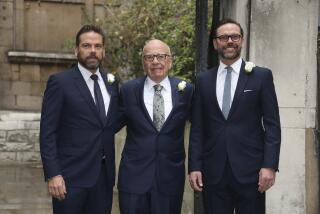Pensions Are the Power in Lockheed’s Fight
- Share via
What’s behind Harold Simmons’ proxy battle for control of Lockheed--and why should you care?
Because the battle exemplifies a couple of trends affecting companies and financial markets in the new decade. One is the increasing difficulties encountered by investors such as Simmons who want to acquire companies--or at least make a profit from stock market action resulting from takeover talk.
The other is an increase in the power and influence of the big pension funds, the investors of retirement income that hold the majority of U.S. corporations’ publicly traded. That’s a trend that could be a lot healthier for companies, their employees, the U.S. economy and even shareholders than the takeover wars of the 1980s.
Here’s how the battle for Lockheed shapes up. Simmons is in the hole. The 58-year-old corporate raider bought into Lockheed last April, when the stock was selling at about $46 a share, and has continued buying ever since. He has now accumulated 18.9% of Lockheed’s stock at a cost of $524 million.
But Lockheed’s stock has declined to $36 a share--so Simmons’ stake is worth about $428 million, and he is losing roughly $100 million on paper.
So he is mounting a proxy battle, asking for the votes of Lockheed shareholders on his proposal to replace the company’s board of directors with his own nominees.
And what would Simmons--a man who parlayed a keen eye for balance sheets and the backing of Drexel Burnham Lambert’s junk bonds into control of a $2-billion (sales) conglomerate in the 1980s--do with Lockheed?
The $9.5-billion (revenue) maker of missiles and military aircraft, including the SR-71 that just sped from Los Angeles to Washington in 68 minutes, is going through some lean times, as are other defense contractors. But that’s not the kind of thing Simmons’ financial skills can remedy.
Nor does Lockheed look to be the kind of honey pot of cash that financial buyers favor. Investment analysts speculate that Simmons wants to get his hands on Lockheed’s pension fund. Financial World magazine says the attraction is Lockheed’s land holdings, which include 225 acres in the Burbank area.
But the pension fund has been placed legally outside an acquirer’s reach. And the land that might reasonably be sold would bring in $3.75 a share, just over 10% of the stock price--which is nice but no bonanza.
Meanwhile, the real story in Simmons’ quest for Lockheed is how weak the threat is. Time was in the last decade when a Simmons takeover bid would attract other offers or he could threaten Lockheed with an all-cash buyout financed with money raised by Drexel Burnham. But Drexel Burnham is no more and cash is hard to come by today--even for Simmons, who likes to boast in the press that he’s a billionaire.
Billionaire or not, Simmons’ true strategy seems to be to force Lockheed to buy back his shares at a premium to the current market price, perhaps by giving him one of its subsidiaries.
But even if it wished to do so, Lockheed may not be able to buy Simmons out because other powerful shareholders would protest.
And that brings up the second trend for the ‘90s. This proxy battle, if it comes off at Lockheed’s March 29 annual meeting, will see the pension funds exert new authority in keeping with their ownership of more than 60% of Lockheed stock. In all likelihood, the funds will vote with Lockheed management but then make recommendations to that management on how the company might improve its earnings and stock performance.
Such active involvement is a step in the evolution of the pension funds, organized in most U.S. companies about 40 years ago to invest retirement funds for employees. The funds now control more than half the stock traded on the major exchanges--more than $2 trillion in investments. But until recently they were passive shareholders who either voted with management or sold the stock when a takeover bid was made.
Now they are being urged to do more by U.S. government regulators. Assistant Secretary of Labor David Ball, the chief pension fund regulator, has suggested that pension funds persuade companies to change policies that result in poor earnings and a low stock price. And Treasury Secretary Nicholas F. Brady has spoken of pension fund shareholders becoming “partners in achieving a corporation’s long-term goals.”
Which sounds impressive, but what does it mean? It means that mergers in the new decade will receive more consideration by major shareholders and be less of a quick-buck phenomenon. So, more than ever, the rule is: Don’t invest in expectation of takeover action; it may never come.
At the present time, the trend means be skeptical of financial buyers such as Simmons or Donald J. Trump or Marvin Davis. If they say in the press that they’re buying a company, it could well be that what they’re really doing is trying to push up the price of the stock so that they can sell.
In the future, the trend to pension fund activism could mean stable ownership for U.S. industry--semi-permanent investors who would support intelligent, long-term research and capital investment by U.S. companies.
A new era is dawning--and it could mean serious business.
More to Read
Inside the business of entertainment
The Wide Shot brings you news, analysis and insights on everything from streaming wars to production — and what it all means for the future.
You may occasionally receive promotional content from the Los Angeles Times.










